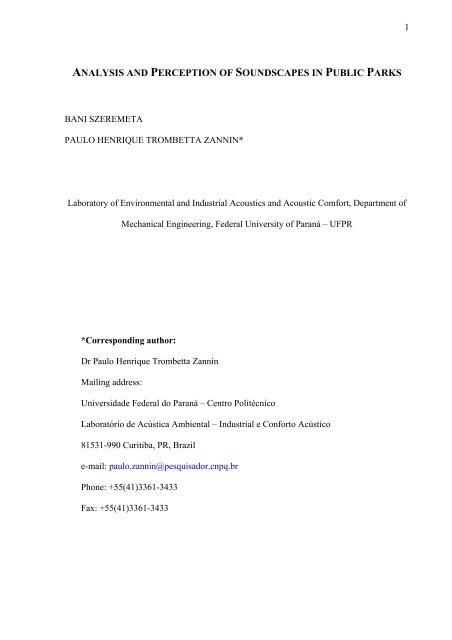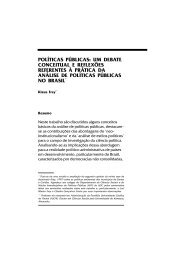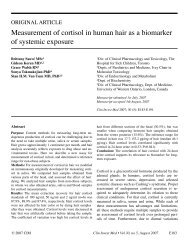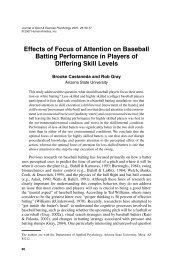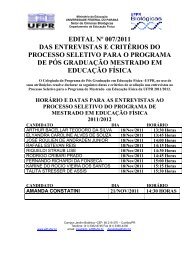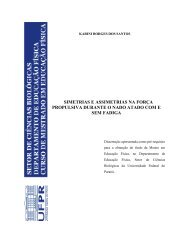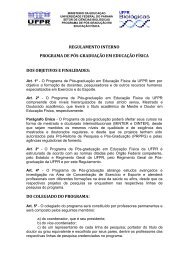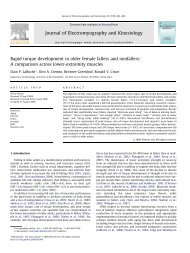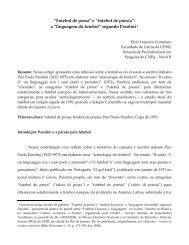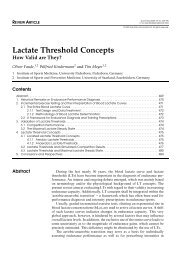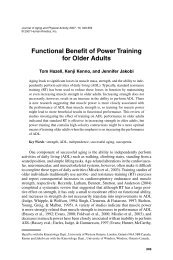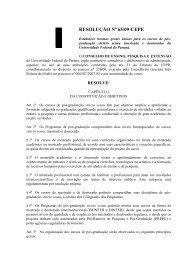BANI SZEREMETA - UFPR - Universidade Federal do Paraná
BANI SZEREMETA - UFPR - Universidade Federal do Paraná
BANI SZEREMETA - UFPR - Universidade Federal do Paraná
Create successful ePaper yourself
Turn your PDF publications into a flip-book with our unique Google optimized e-Paper software.
1<br />
ANALYSIS AND PERCEPTION OF SOUNDSCAPES IN PUBLIC PARKS<br />
<strong>BANI</strong> <strong>SZEREMETA</strong><br />
PAULO HENRIQUE TROMBETTA ZANNIN*<br />
Laboratory of Environmental and Industrial Acoustics and Acoustic Comfort, Department of<br />
Mechanical Engineering, <strong>Federal</strong> University of Paraná – <strong>UFPR</strong><br />
*Corresponding author:<br />
Dr Paulo Henrique Trombetta Zannin<br />
Mailing address:<br />
<strong>Universidade</strong> <strong>Federal</strong> <strong>do</strong> Paraná – Centro Politécnico<br />
Laboratório de Acústica Ambiental – Industrial e Conforto Acústico<br />
81531-990 Curitiba, PR, Brazil<br />
e-mail: paulo.zannin@pesquisa<strong>do</strong>r.cnpq.br<br />
Phone: +55(41)3361-3433<br />
Fax: +55(41)3361-3433
2<br />
Abstract<br />
The parks selected for this study are located in areas very close to streets with intense vehicle<br />
traffic, raising the hypothesis that this proximity impairs the acoustic comfort of their visitors.<br />
The purpose of this work was to investigate the sound environment of public parks in the city<br />
of Curitiba - Paraná - Brazil, using a soundscape study model that analyzes not only noise but<br />
also all the types of sound of a given area, as well as other environmental factors. To this end,<br />
acoustic measurements were made in the parks under study and interviews were held with<br />
their frequent visitors. The findings confirm the strong influence of traffic noise on the<br />
soundscapes of the parks. Other conditions in the parks’ environments were also identified,<br />
which interfere jointly in the soundscape and in its perception, such as the spatial factors of<br />
each park, the urban setting of its surroundings, and the sounds originating inside the parks.<br />
Keywords: noise pollution, public parks, soundscapes, urban noise pollution, parks.
3<br />
1 . Introduction<br />
The soundscape of a city is an important environmental reference of the quality of life<br />
in the urban setting (Pereira, 2003). However, the continuous technological advances of<br />
industrialization and their essential introduction into the life of society over the last century<br />
have led to considerable negative impacts on the urban soundscape, since the noises created<br />
by humanity multiply continuously through these advances (Zannin, 2002). This fact,<br />
combined with the expansion of urban populations and the lack of information and<br />
sensitiveness about the problem of noise pollution, has generated a widely diverse range of<br />
unpleasant noises that are harmful to health and that are present mainly in leisure, professional<br />
and transport (traffic) activities, diminishing and jeopardizing the quality of life, causing<br />
irritability and communication problems, and triggering disorders that alter and impair social<br />
contact (Pimentel Souza, 1997).<br />
In general, the effects of noise on human health can be divided into 3 main categories:<br />
1) subjective effects such as irritation, disturbance, irksomeness (??), etc.; 2) effect on the<br />
development of any specific activity, such as loss of attention, sleep disturbance, interference<br />
on speech communication, etc.; 3) psico-physiological effects, such as anxiety, depression,<br />
headache, digestive malfunction, increase in blood pressure, hearing impairment, etc. (Harris,<br />
1998; ABNT, 2000).<br />
Researchers and society in general are increasingly concerned about this issue, and<br />
there has been a surge in the development of researchers and the creation of laws and<br />
regulations to mitigate the impact of these disagreeable noises in the social environment,<br />
emphasizing the fight against this current and harmful type of pollution (Brown et al., 1994;<br />
Pandya, 2001; Zannin et al., 2002; Zannin and Szeremeta, 2003; Brambilla, 2004; Zannin et
4<br />
al., 2006). Proof of this is that the World Health Organization (WHO, 1999) has categorized<br />
noise as the 3 rd largest type of environmental pollution of that decade.<br />
Studies have also shown that traffic noise of 66 decibels [dB(A)] is considered the<br />
threshold to health impairment. Hence, preventive medicine establishes 65 dB(A) as the<br />
highest level a person can be exposed to without risk in the urban environment (Belojevic et<br />
al., 1997; Maschke, 1999). In Curitiba, noise pollution is monitored based on Law no. 10625<br />
(Municipal Law of December 19, 2002. The Law disposes about urban noises, and public well<br />
being protection.), which establishes the maximum permissible limits of noise by urban zone<br />
and by times of the day. In the case of “green areas”, the highest permissible limit for the<br />
daytime is 55 dB(A). One can therefore understand the importance of the issue of noise levels<br />
in urban environments, since they are the most populous and the scene of the most intensive<br />
human activities.<br />
As for the acoustic term “soundscape” (sound landscape) and its applicability in<br />
acoustic studies, Canadian musician and composer R. Murray Schafer introduced this concept<br />
(soundscape), describing it as any sample of the sound landscape classified as a field of study.<br />
Thus, according to Schafer (2001), the analysis of all types of sounds in a given area or region<br />
is called “soundscape”. In other words, the soundscape consists not only of noises (unpleasant<br />
sounds) but also of a wide range of other sounds that are indispensable in distinguishing and<br />
identifying a place, although in urban environments these sounds are mostly masked by<br />
environmental noise, particularly originating from automotive vehicle traffic. The soundscape<br />
concept thus established gave rise to a new aspect for research of the sound environment and<br />
important studies have been conducted worldwide (Schafer, 2001; Pereira, 2003; Hokao,<br />
2004; Downing et al., 2005).<br />
This progress in the studies on soundscapes is based on the fact that the sound<br />
environment should not be evaluated solely through acoustical determinations. The
5<br />
agreeable/disagreeable nature of the sound phenomena cannot be considered only through the<br />
level (loudness) measured. The perception of sound environment is also influenced by<br />
personal subjective issues, as well as by other characteristics of the environment, such as for<br />
example the weather and the visual landscape (Thibaud, 1998). According to Pereira (2003),<br />
the concept of noise discomfort depends on the circumstance, on the personal activity being<br />
carried out, and the object of attention and interest of a certain person or group of people.<br />
It is thus of relevance to associate and correlate acoustical measurements with other<br />
parameters of evaluation, as for example interviews conducted with the population. This<br />
allows the suggestion of which sounds should be preserved in a certain urban setting, not only<br />
considering the sound levels, but also human perception to them. This approach permits the<br />
formulation of suggestions for the creation of desirable resources and solutions in terms of<br />
acoustical comfort in open urban areas (Pereira, 2003).<br />
Since they are open urban areas, parks are considered “green” areas and their various<br />
roles in a city are of crucial importance, contributing significantly to the quality of life. Green<br />
urban area is therefore considered a special type of free space with a pre<strong>do</strong>minance of planted<br />
areas, which should fulfill three main functions: esthetic, ecological and leisure (Nucci, 2001).<br />
Thus, besides the number of green areas in a city, the quality and distribution of these areas<br />
should be observed, for the indices of the amount of green space per inhabitant, alone, <strong>do</strong> not<br />
suffice to ensure environmental quality in urban areas, even though these indices are normally<br />
employed to ensure this objective (Milano, 1984).<br />
Therefore, although Curitiba has established many parks in the last two decades, little<br />
is known about the environmental factors or agents that influence the way the community<br />
uses these sites and how the users perceive and evaluate these spaces from a social or<br />
ecological standpoint. It is extremely important, therefore, to study aspects of the acoustic<br />
comfort of these places by assessing the soundscape, investigating the relation of the
6<br />
soundscape of these areas with their active visitors. This importance hinges on the fact that<br />
public parks rarely occupy privileged positions in cities (Nucci, 2001) since, besides being<br />
destined for recreation, they are strategically positioned within the urban structure in order to<br />
fulfill several other functions.<br />
The parks chosen for this study are located in strictly urban areas, surrounded by<br />
streets with intense vehicle traffic (Zannin, 2003), which leads to the hypotheses that<br />
Municipal Law # 10625 is being violated and that the acoustic comfort of the parks’ users is<br />
impaired.<br />
The analysis of the soundscape of urban parks is therefore a significant subject of<br />
investigation, considering that these areas, in addition to other roles they play in the urban<br />
environment, are seen as important leisure alternatives for the community and for other<br />
activities relating to visitation. In short, this study assesses the soundscape of public parks in<br />
Curitiba based on acoustic field measurements and on interviews with the users of these areas<br />
to ascertain how they perceive their local soundscape.<br />
2. Materials and Methods<br />
This work was carried out in the city of Curitiba – Paraná, situated at a latitude<br />
25º25’48” south and longitude 49º16’15” west of the Greenwich meridian. The city is located<br />
in the center of the most heavily industrialized region of South America. It covers an area of<br />
432.17 square kilometers and has an estimated population of 1.8 million. It has a humid<br />
subtropical climate, with average temperatures of 19.7ºC in summer and 13.4ºC in winter.<br />
The city, which is also the capital of the state of Paraná, is known nationally and<br />
internationally for its tradition of preserving green areas. Considering only green areas equal<br />
to or larger than 2,000 m², the municipality’s forest cover in 1985 was about 15.1% and
7<br />
corresponded to a mean value of 50.2 m² per inhabitant. Of this total, 9.6 m²/inhabitant (19%)<br />
corresponded to public green areas and 40.6 m²/inhabitant (81%) to private green areas.<br />
According to the municipality’s Environmental Bureau, in 1997 the city had 2 areas of<br />
environmental protection (APAs), 13 parks, 12 public woods, 1,111 private woods, 660 open<br />
public spaces and 1 botanical garden. That same year, the public woods comprised a total<br />
area of 61.23 ha, while the parks accounted for 1,812.99 ha and the open public spaces for<br />
268.60 ha.<br />
The green areas selected for this study were the following parks: Barigüi, São<br />
Lourenço, Jardim Botânico and Passeio Público. Table 1 displays the area of each Park, its<br />
year of foundation, and distances from city center.<br />
Please insert here Table 1<br />
The criterion for this choice was based mainly on the fact that these parks are located<br />
in areas of great urban density, surrounded by streets with heavy vehicle traffic (Zannin et al.,<br />
2006), which leads to the hypothesis of violation of Municipal Law # 10625, which<br />
establishes 55 dB(A) as the maximum noise level permissible for green areas (GA) during the<br />
daytime, and the possible discomfort of the users of these areas. Another factor underpinning<br />
the choice of these parks was the extent (Table 1) and therefore the diversity of uses and<br />
functions these parks make available in the city.<br />
2.1. Acoustic and Spatial Data
8<br />
The acoustic measurements served to assess and analyze mainly the influence of vehicle<br />
traffic in the surroundings of the parks’ soundscapes. This procedure was carried out in the<br />
following steps.<br />
The locations and numbers of points to be measured in the area of each park were<br />
chosen based on the analysis of aerial photographs and on technical visits.<br />
The measurements were taken on the trails or paths (bicycle paths) where the visitors<br />
walk and or carry out their activities. Thus, the location and number of points measured were<br />
defined so as to encompass the internal area of the parks and corresponded to the sites<br />
frequented by the parks visitors, aiming to standardize and control the data and ensure their<br />
reliability.<br />
The sound levels were processed with a Brüel & Kjaer 2238 sound level meter. This<br />
device can measure several different acoustic descriptors simultaneously. To carry out this<br />
study, the calculation a<strong>do</strong>pted to analyze the results was the average equivalent level (L Aeq ),<br />
which is equivalent to the average sound level during the period of measurement.<br />
All the measurements were taken on weekdays (Tuesdays, Wednesdays and Thursdays)<br />
in May, August and September 2006, between 2:00 and 5:00 p.m. This time frame was chosen<br />
to avoid the peak traffic times around noon and late afternoon. Each point was measured for<br />
5 minutes on days without rain or strong winds. This measuring time was chosen so that the<br />
measurements in each park could be carried out in a single day within the stipulated time<br />
frame.<br />
It was also decided to take only one sampling of acoustic data in each park. Thus, no<br />
repetitions were made since observations of the areas and their surroundings indicated that the<br />
flow of vehicle traffic (the main noise agent) in the measured time period remained constant<br />
on weekdays, except on holidays. No measurements were therefore taken during weeks which<br />
had a holiday.
9<br />
The entire measuring procedure was conducted according to the ISO 1996.<br />
Using the Evaluator (BK7820) program, a spatial measurement was taken of the sound<br />
levels (L Aeq ) measured in each park, which resulted in a single value of sound level for each<br />
park. Based on an analysis, the sound levels (L Aeq ) obtained were compared with the 66dB(A)<br />
level, which is considered the threshold of health impairment in urban areas, and with<br />
Municipal Law 10625 of 2002, which establishes 55dB(A) as the maximum permissible level<br />
during the daytime in green areas (GA).<br />
The collection of spatial data involved analyses of the features of the close surroundings<br />
and the typology of the interior of each park. To this end, a variety of thematic maps,<br />
topographic charts and aerial photographs of these areas (Report from the Institute of<br />
Research and Urban Planning of the City of Curitiba - IPPUC, 1996, p. 163) were studied.<br />
Visits were also made to the sites and, using visual analysis and photographic techniques, the<br />
aforementioned spatial features were observed and recorded that might in some way influence<br />
the sound propagation and, hence, the users’ perception of the soundscape. Truax (1984)<br />
stated that “the sound that reaches the ear is analogous to the actual state of the physical<br />
environment, for as it travels, the wave is modified by each interaction with the environment.”<br />
2.2. Interviews<br />
The interview system employed in the four parks of this study was personal and<br />
individual, involving users of these areas and carried out simultaneously to the measuring<br />
process by five previously trained interviewers. A ran<strong>do</strong>m criterium was employed for the<br />
selection of the interviewed people. People have been approached during their activity inside<br />
the Parks in the walking/jogging lanes, volunteering for the survey. To avoid inducing<br />
responses, the interviewees were instructed not to mention, under any circumstance
10<br />
whatsoever, that the research was aimed at analyzing the soundscape or the acoustic comfort<br />
of the site. Instead, they were to explain that the interview was about the park’s environmental<br />
quality, giving the proposal a more general aspect.<br />
The questionnaire used for this interview consisted of closed-ended and open-ended<br />
questions, which were divided into three main sections. The first section comprised<br />
identifying data of the interviewee, the second involved characteristics of the user’s profile in<br />
terms of his use of the park, and the third covered aspects of his perception of the soundscape<br />
and environmental quality of the park. The third section of the questionnaire was prepared<br />
based on a metho<strong>do</strong>logy tested and validated by Pereira for the study of sound perception in<br />
public spaces in the city of Rio de Janeiro (Pereira, 2003), with a few minor adaptations for<br />
the present study. This part consisted of five open-ended questions (1-5) and 2 closed-ended<br />
questions (6 and 7) on a Likert scale:<br />
1- In your opinion, what is the most pleasant aspect of the park’s environment?<br />
2- What is the aspect of the park you find the most unpleasant?<br />
3- With regard to the sounds you are hearing, which of them can you identify?<br />
4- Which of these sounds <strong>do</strong> you consider pleasant?<br />
5- Which of these sounds <strong>do</strong> you find unpleasant?<br />
6- What <strong>do</strong> you think of the volume of the environmental sound?<br />
7- Does this volume bother you?<br />
Note that none of these questions involved the word “noise” in order to avoid inducing<br />
responses about this issue. The word “noise” (negative connotation) was replaced by “sound”<br />
(neutral connotation). Another aspect of non-induction is that spontaneous remarks about the
11<br />
soundscape in questions 1 and 2 were considered, advancing progressively toward the user’s<br />
perception of sound but not leading him to this aspect from the start.<br />
In question 3, all the sound-related events identified by the interviewee were recorded.<br />
These events were catalogued according to their referential aspects, based on Schafer’s<br />
classification (2001), which was used in one of the subprojects of the World Soundscape<br />
Project: a) Traffic sounds, b) Human sounds, c) Natural sounds, d) Bird sounds, e) Machinerelated<br />
sounds, f) Music-related sounds, g) Communication or Signaling-related sounds, and<br />
h) Others (that <strong>do</strong> not fit the aforementioned items).<br />
Questions 4 and 5 concerned the users’ opinions about the esthetic quality of the<br />
sounds they identified. The importance of these questions lies in the fact of knowing which<br />
sounds should or should not be preserved in the environment under study.<br />
3. Results and Discussion<br />
3.1. Acoustic data<br />
Fifty-five points were assessed in the 4 areas studied (Table 2), each point measured for<br />
a period of 5 minutes, making a total of 4 hours and 35 minutes of measurements.<br />
Please insert here Table 2<br />
The Jardim Botânico and Passeio Público parks showed average spatial sound pressure<br />
levels well above 55 dB(A), the level established by Curitiba’s Municipal Law # 10625 as the<br />
limit permitted for green areas during the daytime. The São Lourenço and Barigüi parks<br />
showed average sound levels very close to that established by this law.
12<br />
3.2. Interviews<br />
A total of 335 people were interviewed in the 4 parks of this study. Table 3 shows the<br />
number of interviews conducted in each park.<br />
Please insert here Table 3<br />
3.2.1. Sound and Environmental Perception in the Parks<br />
The answers of the 335 interviewees in the 4 parks to questions 1 and 2 indicate a<br />
higher rate of spontaneous evocation of pleasant aspects of the soundscape (23%) than of<br />
disagreeable ones (4.5%).<br />
The answers to the question about the most agreeable aspects (figura 1) referred<br />
mostly to the visual landscape (53%), particularly the beauty and exuberance of the vegetation<br />
in the parks. This is congruent with Milano (1984), who states that the vegetation is<br />
responsible for the creation of esthetically pleasing environments, which give value to an area<br />
and act as a stress-mitigating element (Figure 1).<br />
Please insert here Figure 1<br />
In the Jardim Botânico, 21% of the interviewees who spontaneously mentioned the<br />
soundscape in the question about the pleasant aspects (19 instances), 11 referred to the park’s<br />
tranquility, 6 mentioned birdsong, and 2 mentioned the silence. In the Passeio Público, of the
13<br />
24% of interviewees spontaneously mentioning the soundscape (15 instances), 8 referred to<br />
the tranquility and 7 to birdsong. In São Lourenço park, of the 20 people who mentioned the<br />
sound environment (22%), 7 referred to the park’s silence, 7 to the tranquility and 5 to the<br />
birdsong. In Barigüi park, of the 26% interviewees who spontaneously referred to the<br />
soundscape (23 instances), 15 mentioned the tranquility, 3 talked of birdsong, and 2<br />
mentioned music.<br />
The most frequently cited unpleasant aspect of São Lourenço and Barigüi parks was<br />
water pollution. In the Passeio Público, the factor causing the most distress was the presence<br />
of prostitutes and vagrants in the park. In the Jardim Botânico, most of the interviewees (55%,<br />
50 instances) stated they found no unpleasant aspect in the environment (Figure 2).<br />
Please insert here Figure 2<br />
With respect to the soundscape in Jardim Botânico, only 7.6% of the interviewed<br />
people spontaneously evoked any sound as being disagreeable (7 occurrences), 5 mentioning<br />
the surrounding traffic noise and 2 mentioning the noise from lawn mowers. In the Passeio<br />
Público, only one person specifically mentioned the noise of buses from the surroundings. In<br />
São Lourenço park, only 2 interviewees mentioned feeling bothered by the noise of<br />
surrounding traffic. In Barigüi park, 5.7% of the interviewees (5 instances) mentioned soundrelated<br />
aspects, while 3 mentioned the quality of the music coming from the snack bars<br />
situated in the park.<br />
In answer to question 3, about the identification of sounds, most of the interviewees<br />
mentioned more than one sound event and also different categories. Together, the 335<br />
interviewees identified 852 sound events, according to their referential aspect (Schafer, 2001),
14<br />
distributed in 10 groups: birds, vehicle traffic, people, other sounds of nature, machines,<br />
music, air traffic, warning signals, trains, and others.<br />
The sounds of birds, vehicle traffic, other natural sounds and people were identified<br />
regularly in the area of the 4 parks, making up a total of 89.9% of the sample and confirming<br />
that these are the principal sounds that make up the soundscape of these areas. Thus, 32.6% of<br />
the references involved birdsong, 28.5% vehicle traffic, 15.8% other natural sounds, and 13%<br />
referred to human sounds (Table 4).<br />
Please insert here Table 4<br />
An individual analysis of each park revealed that the sound most frequently identified<br />
in the Passeio Público, São Lourenço and Barigüi parks was birdsong, which was mentioned<br />
by 39.4%, 36% and 26.5% of the interviewees, respectively. This was followed, in the same<br />
park, by vehicle traffic sounds, which were mentioned by 26%, 30% and 23.8% of the<br />
interviewees.<br />
In contrast, in the Jardim Botânico, the sound most frequently mentioned was noise<br />
from surrounding vehicle traffic (34.4%). However, birdsong was mentioned less frequently<br />
(31.6%). In this park in particular, train sounds were also mentioned 12 times (5.6% of the<br />
interviewees), since a railroad passes right alongside the park.<br />
Although the Passeio Público is located <strong>do</strong>wntown, where it is easy to see the negative<br />
impact of intense vehicle traffic on its soundscape, this park is the one with the highest<br />
percentage of identified natural sounds. Together, the “bird sounds” and “other natural<br />
sounds” corresponded to 59.4% of the sounds perceived in this area. The reason for these<br />
answers may be the fact that this space is covered in abundant vegetation, in addition to the<br />
presence of various species of bird and monkeys in cages, which sing and scream loudly.
15<br />
Barigüi was the only park where other natural sounds were mentioned fewer times<br />
than human sounds, i.e. 13.7% versus 18%. This is understandable when one considers that<br />
this park has a much larger area and receives more daily visitors than the other parks of this<br />
study (Hildebrand, E, personal communication). Barigüi park also had a more diversified<br />
soundscape than the other parks because the types of sounds identified were more uniformly<br />
distributed. For example, in addition to the types of sounds that were common to the four<br />
parks, machine sounds were reported by 8.2% of the interviewees (21 instances) and musical<br />
sounds by 5.8% (15 instances). The sound of machines came from lawnmowers and from an<br />
amusement park set up on the park’s grounds and the music originated from the park’s snack<br />
bars and restaurants.<br />
Thus, given the answers provided to question 3, it is apparent that even in conservation<br />
areas such as public parks, traffic noise is easily perceived, adding up to 28.5% of all sounds<br />
mentioned in the 4 parks. However, it <strong>do</strong>es not <strong>do</strong>minate the soundscape of these spaces as it<br />
<strong>do</strong>es in most open urban environments, since people are able to identify different sound<br />
events. This demonstrates the diversity of sounds in the soundscape, as well as the<br />
intelligibility of this environment, where sounds can be heard distinctly. In other words, the<br />
surrounding traffic noise <strong>do</strong>es not mask other sounds coming from inside the park, especially<br />
birdsong, human sounds and other sounds of nature (wind, water, trees and other animals).<br />
With regard to the opinion (questions 4 e 5) about the esthetic quality of the sounds,<br />
68.2% of the 852 sound events identified were considered pleasant and 31.8% unpleasant. In<br />
the response to question 4, all the “bird” and other “natural” sounds identified were deemed<br />
pleasant by the interviewees in the 4 studied areas. Human sounds were also mostly<br />
considered pleasant (86.4%). Figure 3 displays the number of assertions relative to pleasant<br />
sounds identified in each park.
16<br />
Please insert here Figure 3<br />
In response to question 5, most of the sounds identified as vehicle traffic were<br />
considered unpleasant (84.2%) in the 4 parks, although some of the interviewees had<br />
classified this sound as pleasant in the previous question. This was particularly true in Barigüi<br />
park, where, of the 61 references to this type of sound, 36.% considered it pleasant. At the<br />
Jardim Botânico, 19% of the 74 references to this type of sound considered it pleasant . Figure<br />
4 displays the number of assertions concerning disagreeable sounds identified in each park.<br />
Please insert here Figure 4<br />
Analyzing the responses to questions 4 and 5, one can see that birdsong, human<br />
sounds and other sounds of nature should be preserved in the parks’ environments. To this<br />
end, effective alternatives should be sought to protect these areas from exposure to the various<br />
polluting agents common to urban areas since one of the roles of parks, in their capacity as<br />
institutions of conservation, is to protect the natural elements, thereby ensuring their best<br />
environmental quality. Therefore, a policy of protection of the surroundings, especially<br />
insofar as land use is concerned, should be taken into account in the pre-and postimplementation<br />
of parks. Poor planning may impair the vegetation and/or fauna of these sites,<br />
and hence, their soundscapes, since a well balanced soundscape requires a well balanced<br />
environment. Indeed, an analysis of the number of references to the type of sounds identified<br />
by the interviewees, as well as the acoustic data, indicate that traffic noise, which the majority<br />
(84.2%) considered unpleasant , is present quite intrusively even in places such as these parks.<br />
Table 5 displays the percentage and absolute number of opinions referring to the level of<br />
noise in each park.
17<br />
Please insert here Table 5<br />
As for questions 6 (Table 5) and 7 (Table 6), the opinion of most of the 335<br />
interviewees about the sound level of the environment is that it is normal (72%) and not<br />
irksome (81.5%), although all the parks presented spatial averages of sound pressure levels<br />
exceeding the limit of 55 dB(A) permitted by Curitiba’s municipal law 10625. Table 6<br />
displays the percentage and number of opinions referring to the irksomeness from the sound<br />
levels detected in each park.<br />
Please insert here Table 6<br />
Although the Jardim Botânico ranked second in this study in terms of sound levels,<br />
with a spatial average of 61.6 dB(A), showing the strong influence of the intense traffic in the<br />
surrounding streets, most of the interviewees considered the sound level of the environment<br />
normal (62.6%) and only 26.4% stated they found this sound level irksome to some extent (“a<br />
little”, more or less”, or “very” irksome). However, among the spaces studied here, this is the<br />
one with the highest percentage of people bothered by the sound level, although more than<br />
half of them (14.3%) were only “a little” bothered.<br />
The Passeio Público, located <strong>do</strong>wntown and completely surrounded by streets with<br />
heavy vehicle traffic, showed the highest sound pressure levels of the four parks, with a<br />
spatial average of 63.9 dB(A). Even so, most of its visitors considered the ambient sound<br />
level normal (73.8%) and only 23,1% stated they irked by it. However, compared to the other<br />
parks, this one presented the highest percentage of people who stated they were “more or<br />
less” (12.3%) or “very” (4.6%) bothered.
18<br />
At São Lourenço park, the responses to questions 6 and 7 showed values (%) very<br />
similar to those of the Passeio Público, although it presented relatively much lower sound<br />
levels (spatial average of 55.6 dB(A)) and dissimilar spatial characteristics. One example of<br />
this is that it is located in a much quieter neighborhood (strictly residential), while the Passeio<br />
Público is situated <strong>do</strong>wntown. Thus, 72% considered the sound level normal and only 21.7%<br />
found it irksome.<br />
Barigüi park showed a spatial average sound level of 56.9 dB(A), which was attributed<br />
to the fact that it is surrounded mostly by residential areas and high traffic streets in the<br />
surroundings exert less influence on its soundscape especially due to its large size. This size,<br />
in response to question 7, stood out for presenting a much lower rate (3.5%) of irked people<br />
compared with the other parks. This finding was corroborated by the lowest and highest<br />
percentage of answers rating the environment’s sound level, respectively, as “high” (2.3%)<br />
and “low” (16%).<br />
A comparison of the interview data and the results of the acoustic measurements<br />
indicated the visitors to these spaces have a certain tolerance to high sound levels. In fact, of<br />
the 335 people interviewed in the four parks, only 18.5% stated the “sound volume” bothered<br />
them to any extent (“a little”, “more or less”, or “very”), while a minority (11.3%) judged it to<br />
be high.<br />
In the Passeio Público and Jardim Botânico this tolerance was even higher, since both<br />
presented far higher sound pressure levels than that permitted by Municipal Law 10625, and<br />
some points showed levels as high as 66 dB(A), a level considered borderline to health risk.<br />
It should also be kept in mind that traffic noise from the surroundings was the second<br />
type of sound most frequently identified in all the parks except the Jardim Botânico, where it<br />
topped the list of identified sounds. This response makes the influence of traffic noise more
19<br />
evident and was confirmed by the acoustic measurements of the soundscape of these green<br />
areas, thus emphasizing the visitors’ tolerance to high sound pressure levels.<br />
This tolerance was revealed by the fact that the interviewees identified more pleasant<br />
sounds of nature (68.2%) than unpleasant sounds (31.8%). In other words, the perceived<br />
ambient sound level was composed not only of traffic noise and other unpleasant noises but<br />
also, and mainly, of pleasant natural sounds. Another point that reinforces this idea and<br />
justifies the reported lack of irksomeness is that the interviewees made more spontaneous<br />
reference to the soundscape in terms of its pleasantness (23%) than its unpleasantness (4%).<br />
These findings confirm that, in the presence of a pleasant sound such as birdsong, for<br />
example, the degree of irksomeness of the sound level prevailing in the soundscape is<br />
relatively low. Thus, the presence of pleasant sounds can improve acoustic comfort<br />
considerably, even when the sound level is quite high (Feiber, 2004; Yang and Kang, 2005).<br />
Another factor that may have influenced the perception of the ambient sound<br />
“volume” is the parks’ visual landscape, especially their vegetation, which was found to be<br />
judged the most pleasant aspect. Previous studies have shown that the mere presence of<br />
vegetation renders the environment pleasing (Milano, 1984; Pereira, 2003), and may thus<br />
reduce the feeling of irksomeness caused by high sound levels.<br />
4. Conclusions<br />
This study led to the following conclusions about the four parks: The sound level at<br />
most of the points evaluated (65.45%) in the parks exceeded the 55 dB(A) limit established by<br />
Curitiba’s municipal law 10625 (2002) as acceptable for Green Areas. These acoustically<br />
polluted sites are located around the park’s perimeter and are therefore closer to the streets
20<br />
with intense vehicle traffic, confirming the influence of these noise sources on the<br />
soundscapes of these public spaces.<br />
The Jardim Botânico and Passeio Público parks, whose spatial averages of sound<br />
pressure levels were 61.6 and 63.9 dB(A), respectively, are completely surrounded by streets<br />
with heavy traffic and they border on different areas of the city. On the other hand, São<br />
Lourenço and Barigüi parks, whose spatial averages were closer to the legally established<br />
limit, i.e., 55.6 dB(A) and 56.9dB(A), respectively, border mainly on strictly residential areas.<br />
Therefore, heavy street traffic in the surroundings <strong>do</strong>es not affect the soundscapes of these<br />
parks to any appreciable extent since they are not completely surrounded by such streets,<br />
unlike the case of the two former parks.<br />
An analysis of these urban elements and other spatial and acoustic characteristics of<br />
each of the four areas under study indicated that their soundscapes are affected by several<br />
factors. These factors include environmental and urban zoning, land use, main traffic routes,<br />
residential streets, vegetation, type of public transportation, and the park’s typology and the<br />
sounds coming from inside it.<br />
It was therefore found that the identification and study of these factors can serve as an<br />
important tool to define an urban project compatible with the functions and uses of green<br />
urban areas. Provided they are used correctly and are based on proper planning and<br />
management, these factors can promote a greater sense of acoustic comfort. The assimilation<br />
of these factors also demonstrates the importance of interdisciplinarity in the study of<br />
different soundscapes. In other words, assessments of the sound environment should not be<br />
based solely on acoustically measurable data, but should include the analysis and correlation<br />
of other parameters.<br />
The results of the interviews clearly indicate this need. This method enabled us to<br />
discover how people perceive the soundscape of the parks and to gain a better understanding
21<br />
of acoustic comfort. It was found that the level of discomfort or comfort of a population is not<br />
necessarily connected only to sound levels, but includes other factors (acoustic and nonacoustic)<br />
in the environment and in the receiver himself.<br />
With regard to the question about unpleasant aspects, which aimed to elicit<br />
spontaneous references to the soundscape, the responses of most of the interviewees indicated<br />
that issues relating to noise pollution take a back seat to concerns such as water pollution and<br />
social problems (prostitution and vagrancy). These findings have important implications: 1)<br />
the visual features (non-acoustic conditions) of the landscape, such as vegetation, fauna, the<br />
contrast to its grey urban surroundings, and the sound qualities (acoustic conditions)<br />
perceived for being different from traffic noise, such as the sounds of birds, wind, water, and<br />
even of people inside the park, overcome the negative impact of the noise produced in the<br />
surroundings and jointly affect the perception of the soundscape. 2) The lack of concern on<br />
the part of the authorities and the visitors’ lack of information about sound pressure levels<br />
may cause them to remain exposed to noise pollution for long periods and not demand that the<br />
authorities take steps to remediate the situation.<br />
Another finding was that traffic noise ranked in second place among the most<br />
frequently identified types of sound and was considered unpleasant by the majority. However,<br />
that <strong>do</strong>es not mean this element <strong>do</strong>es not strongly affect the soundscapes of open urban<br />
environments and that it should not be given its due importance so that measures can be taken<br />
to mitigate its environmental impact. Nevertheless, in terms of the sound level, this type of<br />
sound did not have the same impact on the perception of the interviewees, most of whom<br />
considered the ambient sound level normal and not irksome. It should be noted that the<br />
interviewees were not asked specifically about the sound level of the traffic noise, but the<br />
question considered the “volume” of the soundscape as a whole. This was because the sound<br />
environment of parks is composed of different kinds of sounds, indicating that these places
22<br />
have a “sound identity” even when located in the midst of an environment that is prone to<br />
noise pollution. This definitively confirms the importance of analyzing the environment<br />
according to the soundscape study model. If the parks’ sound environments were evaluated<br />
based solely on comparisons of the ambient sound levels and the limit established by law, or<br />
only on the visitors’ opinions about these levels, any judgment about the acoustic comfort of<br />
these sites would un<strong>do</strong>ubtedly be arbitrary.<br />
The main hypothesis of this work was that environmental comfort was impaired by the<br />
fact that the parks in question are located in acoustically polluted regions (high noise levels).<br />
However, the interviewees proved to be more concerned with the esthetic (unpleasant) aspects<br />
of traffic noise, without, of course, disregarding the negative effect on acoustic comfort that<br />
this esthetic quality may have. Thus, it proved very difficult to assess ambient sound levels<br />
based on qualitative parameters because people’s perception of soundscapes is influenced by<br />
a combination of various factors.<br />
In short, the opinion of the population in conjunction with the analysis of quantitative<br />
parameters is effective and can be very important for a better understanding and identification<br />
of the qualities that confer environmental comfort, in order to provide effective support for<br />
urban projects.<br />
This study is considered innovative in its use of the soundscape assessment model in<br />
open areas in the city of Curitiba. The aim was to obtain an initial impression of how the<br />
parks’ visitors relate to their soundscapes. No <strong>do</strong>ubt increasingly in-depth studies and<br />
analyses involving professionals from different fields of knowledge will provide additional<br />
information and further interpretations about the soundscapes of parks and other public<br />
spaces, revealing the wealth of detail of the subject and the complexity of man’s relation with<br />
the sound environment.
23<br />
Based on the findings of this research, with regard to alternatives for improving the<br />
environmental quality and conservation of public parks in terms of their soundscapes, the<br />
following points are recommended:<br />
• In the case of parks that are or will be established in areas as yet little urbanized, implement<br />
an efficient policy aimed at defining a “buffer zone” in the proximities of the park<br />
(surroundings), in which more rigid land use criteria must prevail. In other words, stipulate<br />
that the areas surrounding the park area must also be considered sensitive to sound<br />
pollution and other types of pollutants, and provide an urban design compatible with the<br />
functions and uses of parks, with more open and wooded areas. This measure would also<br />
aid in the preservation of natural sounds, which are important elements for the quality of<br />
the soundscape.<br />
• In the design of parks, consider the location of sites for people to sit and walk, seeking,<br />
whenever possible, to place them or establish them far away from surrounding streets with<br />
heavy traffic, thereby giving them greater acoustic comfort. In this study, we found that<br />
walking trails were often situated very close to the external perimeter of the parks, as were<br />
other areas of the park, especially those equipped with physical workout devices.<br />
References<br />
ABNT - ASSOCIAÇÃO BRASILEIRA DE NORMAS TÉCNICAS. NBR-10.151: Avaliação<br />
<strong>do</strong> ruí<strong>do</strong> em áreas habitadas visan<strong>do</strong> o conforto da comunidade. (in portuguese, Brazilian<br />
Association of Technical Standards: Evaluation of noise in inhabited areas, aiming at<br />
community comfort.) Rio de Janeiro, 2000.
24<br />
Belojovic, G., Jakovlevic, B., Aleksiclc, O., 1997. Subjective reactions to traffic noise with<br />
regard to some personality traits. Environ. Int. 23, 221-226.<br />
Brambilla, G., 2004. Noise and soundscape in Rome. In: 147º Meeting of the Acoustical<br />
Society of America. New York, pp. 24-28.<br />
Brown, A.L., 1994. Exposure of the Australian Population to Road Traffic Noise. Appl.<br />
Acoust. 43, 169-176.<br />
Downing, M., Hobbs, C., 2005. Challenges of characterizing natural soundscapes. In: 2005<br />
International Congress on Noise Control Engineering – INTERNOISE, Rio de Janeiro,<br />
Brazil.<br />
Feiber, S.D., 2004. Áreas Verdes Urbanas, Imagem e Uso – O Caso <strong>do</strong> Passeio Público de<br />
Curitiba – PR. (in portuguese, Urban green areas, Image and Use – The case of the<br />
Passeio Público in Curitiba) RA’E GA, Curitiba 8, 93-105.<br />
HARRIS, C. M. 1998. Handbook of Acoustical Measurements and Noise Control. 3 ed.<br />
New York: McGraw-Hill, 1646 p.<br />
Hokao, K., 2004. Research on the Sound Environment of Urban Open Space from the<br />
Viewpoint of Soundscape – A Case Study of Saga Forest Park, Japan. Acta Acustica<br />
United with Acustica 90, 555-563.<br />
ISO - INTERNATIONAL ORGANIZATION STANDARTIZATION., 1996. ISO 1996-1,<br />
Acoustics - Description and measurement of environments noise - Part 1: Basic quanties<br />
and procedures. Geneva.<br />
Maschke, C., 1999. Preventive medical limits for chronic traffic noise exposure. Acustica, 85,<br />
448.<br />
Milano, M.S., 1984. Avaliação e análise da arborização de ruas de Curitiba. (in portuguese,<br />
Evaluation and analysis of street arborization in Curitiba). Masters thesis from the <strong>Federal</strong><br />
University of Paraná, Curitiba.
25<br />
Nucci, J.C., 2001. Qualidade Ambiental e adensamento urbano. (in portuguese,<br />
Environmental quality and urban growth.) São Paulo: Editora Fapesp.<br />
Pandya, G.H., 2001. Urban noise – A need for acoustic planning. Environ. Monit. Assess. 67,<br />
379-388.<br />
Pereira, M., 2003. Percepção Sonora no Espaço Público: Indica<strong>do</strong>res de Tolerância ao Ruí<strong>do</strong><br />
na Cidade <strong>do</strong> Rio de Janeiro. (in portuguese, Noise perception in the public space:<br />
indicators of noise tolerance in the city of Rio de Janeiro) In: National Meeting of Confort<br />
in the Built Environment, Curitiba, Brazil, 779-786.<br />
Schafer, M., 2001. A Afinação <strong>do</strong> Mun<strong>do</strong>. (Soundscapes) Editora UNESPE, São Paulo. 384p.<br />
2001.<br />
Truax, B., 1984. Acoustic Communication, New Jersey: Ablex Publishing.<br />
Yang, W.; Kang, J., 2005. Acoustical comfort evaluation in urban open public spaces. Appl.<br />
Acoust. 66, 211-229.<br />
WHO (World Health Organization), 1999. Guidelines for Community Noise, WHO-expert<br />
task force meeting held in Lon<strong>do</strong>n, April, UK.<br />
Zannin, P.H.T., Calixto, A., Diniz, F.B., Ferreira, J.A., 2002. Incômo<strong>do</strong> causa<strong>do</strong> pelo ruí<strong>do</strong><br />
urbano à população de Curitiba. (in portuguese, Annoyance caused by urban noise to the<br />
population of Curitiba) J. Public. Health (Revista de Saúde Pública, in Portuguese), 36<br />
(4), 521-524.<br />
Zannin, P.H.T., Diniz, F.B. 2002. Environmental noise pollution in the city of Curitiba,<br />
Brazil. Appl. Acoust. 63, 351-358.<br />
Zannin, P. H. T., Szeremeta, B. 2003. Avaliação da poluição sonora no parque Jardim<br />
Botânico de Curitiba, Paraná, Brasil. (in portuguese, Evaluation of noise pollution in the<br />
park Jardim Botânico of Curitiba, Paraná, Brazil), Public Health Rep. (Cadernos de<br />
Saúde Pública, in portuguese), 19 (2), 683-686.
26<br />
Zannin, P. H. T., Ferreira, A.M.C., Szeremeta, B. 2006. Evaluation of noise pollution in<br />
urban parks. Environ. Monit. Assess. 118, 423-433.<br />
Figure 1 – Number of statements about the pleasant aspects of each park<br />
Number of statements<br />
60<br />
50<br />
40<br />
30<br />
20<br />
10<br />
0<br />
52<br />
46 44<br />
35<br />
23<br />
19 20<br />
15<br />
15 13<br />
10<br />
8<br />
4 4 5 4<br />
1 3 2 3 2 3 4<br />
0<br />
Soundscape Animals Air Infrastructure Location Landscape<br />
Botânico Passeio Público São Lourenço Barigüi<br />
Figure 2 – Number of statements about the unpleasant aspects of each park<br />
Number of statements<br />
60<br />
50<br />
40<br />
30<br />
20<br />
10<br />
0<br />
7<br />
1 2 5<br />
50<br />
21<br />
17 17<br />
27<br />
10<br />
5 8<br />
0 0 0 3<br />
48<br />
39<br />
4<br />
7<br />
0 3 4<br />
0 3 5 6 6<br />
0 1 0 1 3<br />
6 7<br />
1 0 0 0<br />
18<br />
Soundscape<br />
No<br />
unpleasant<br />
aspect<br />
Prostitution<br />
Vagrants<br />
Water<br />
Polution<br />
Dirt<br />
Air<br />
Infrastructure<br />
Lack of<br />
safety<br />
Domestiic<br />
Animals<br />
Botânico Passeio Público São Lourenço Barigüi
27<br />
Figure 3 – Number of references to pleasant sounds identified in the parks<br />
Number of references<br />
100<br />
80<br />
60<br />
40<br />
20<br />
0<br />
83<br />
68 68<br />
59<br />
19 22<br />
12<br />
42<br />
41<br />
2930<br />
35<br />
Birds People Sounds of<br />
Nature<br />
22<br />
14<br />
4 8<br />
9<br />
0 2 0 3 0 0 2 0 2 6<br />
1<br />
Vehicle<br />
Traffic<br />
Music Air Traffic Others<br />
Botânico Passeio público São Lourenço Barigüi<br />
Figure 4 – Number of references to unpleasant sounds identified in the parks<br />
Number of references<br />
80<br />
60<br />
40<br />
20<br />
0<br />
60<br />
35<br />
61<br />
39<br />
Vehicle<br />
Traffic<br />
21<br />
12<br />
3 6<br />
0 0 0 0 0 4 3 4 4 1 0 0 3 2 3 6<br />
0 3 0 0 0 0 0 1<br />
Machine Music People Air Traffic Signalingrelated<br />
sounds<br />
Train<br />
Others<br />
Botânico Passeio público São Lourenço Barigüi<br />
Table 1 – Area, distance from the city center, and year of foundation of the parks<br />
Urban Parks Founded Area (m 2 ) Distance from Center (km)<br />
Passeio Público 1886 69,285 Downtown<br />
Barigüi 1972 1,400,000 5.00<br />
São Lourenço 1972 203,000 3.50<br />
Jardim Botânico 1991 270,000 2.50<br />
Table 2 – Number of points measured and spatial average of the L Aeq in each park<br />
Urban Parks<br />
Number of points measured L Aeq dB (decibels)
28<br />
Jardim Botânico 15 61.6<br />
Passeio Público 15 63.9<br />
Parque São Lourenço 12 55.6<br />
Parque Barigüi 13 56.9<br />
Table 3 – Number of interviews conducted in each park.<br />
Name of Park<br />
Number of Interviews<br />
Jardim Botânico 91<br />
Passeio Público 65<br />
Parque São Lourenço 92<br />
Parque Barigüi 87<br />
Table 4 – Number (Absolute Frequency – AF) and percentage of references to the<br />
types of sounds in the parks<br />
Parks<br />
Question 3 Botânico Passeio Público São Lourenço Barigüi<br />
Identified Sounds % AF % AF % AF % AF<br />
Birds<br />
31.6 68 39.4 59 36 83 26.5 68
29<br />
Vehicle traffic<br />
Other sounds of nature<br />
People<br />
Machines<br />
Music<br />
Air traffic<br />
Warning signals<br />
Trains<br />
Others<br />
Total<br />
34.4 74 26 39 30 69 23.8 61<br />
13.4 29 20 30 17.6 41 13.7 35<br />
10.7 23 10 15 11.2 26 18 46<br />
1.4 3 0 0 0 0 8.2 21<br />
0 0 1.3 2 0 0 5.8 15<br />
1.9 4 0 0 0 0 2 5<br />
1.0 2 2 3 0 0 1.2 3<br />
5.6 12 0 0 0 0 0 0<br />
0 0 1.3 2 5.2 12 0.8 2<br />
100 215 100 150 100 231 100 256<br />
Table 5 – Number and percentage of references to sound levels of the parks’<br />
environments<br />
Level of<br />
Ambient Sound<br />
Parks<br />
Botânico Passeio Público São Lourenço Barigüi<br />
No. % No. % No. % No. %
30<br />
Noticed nothing<br />
7 7.7 2 3.1 6 6.5 1 1.2<br />
Low<br />
14 15.4 4 6.1 8 8.5 14 16<br />
Normal<br />
57 62.6 48 73.8 66 72 70 80.5<br />
High<br />
13 14.3 11 17 12 13 2 2.3<br />
Total 91 100 65 100 92 100 87 100<br />
Table 6 – Number (Absolute Frequency – AF) and percentage of references to the<br />
irksomeness of the sound level in the parks’ environments<br />
Parks<br />
Irksomeness<br />
None<br />
A little<br />
More or less<br />
Very<br />
Total<br />
Botânico Passeio Público São Lourenço Barigüi<br />
AF % AF % AF % AF %<br />
67 73.6 50 76.9 72 78.3 84 96.5<br />
13 14.3 4 6.2 10 10.9 2 2.3<br />
8 8.8 8 12.3 7 7.6 0 0<br />
3 3.3 3 4.6 3 3.2 1 1.2<br />
91 100 65 100 92 100 87 100
31<br />
Legends to Figures<br />
Figure 1 – Number of statements about the pleasant aspects of each park<br />
Figure 2 – Number of statements about the unpleasant aspects of each park<br />
Figure 3 – Number of references to pleasant sounds identified in the parks<br />
Figure 4 – Number of references to unpleasant sounds identified in the parks<br />
Tables legends<br />
Table 1 – Area, distance from the city center, and year of foundation of the parks<br />
Table 2 – Number of points measured and spatial average of the L Aeq in each park<br />
Table 3 – Number of points measured in each park<br />
Table 4 – Number (Absolute Frequency – AF) and percentage of references to the types of<br />
sounds in the parks<br />
Table 5 – Number and percentage of references to the sound level of the parks’ environments<br />
Table 6 – Number (Absolute Frequency – AF) and percentage of references to the<br />
irksomeness of the sound level in the parks’ environments


